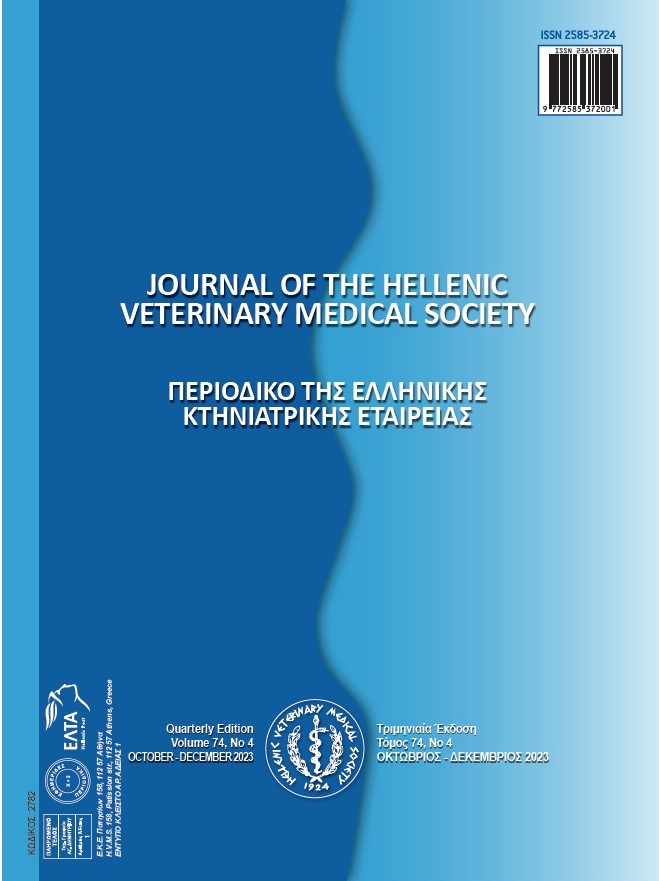Effect of Fluid Therapy and Oxygen Application on Venous Blood Parameters of Diarrheic Calves with Hyperkalemia

Περίληψη
The purpose of this study was to evaluate the effect of oxygen therapy on clinical, hematological, biochemical and venous blood gases in diarrheic calves with hyperkalemia in addition to routine diarrhea and fluid-electrolyte therapy. Animal material was consisted of 20 diarrheic and hyperkalemic calves, with different ages. Diarrheic calves with serum potassium levels greater than 6 mmol/L were included in the study following the clinical examination and analysis results. The calves were divided into 2 groups. Calves in the 1st Group (n=10) received routine diarrhea and fluid-electrolyte treatment and calves in the 2nd Group (n=10) received routine diarrhea and fluid-electrolyte treatment as well as oxygen applications by mask. Blood samples were taken from the animals for blood gases, hematological and biochemical analyses. The decrease in heart and respiratory rate was more significant in the 2nd group when compared to the 1st group. When statistically comparing the same time periods of both two groups, heart rates were lower in the oxygen applied group and this decrease was statistically significant. In the 2nd group; decrease in WBC, Lym, RBC, Hct%, Hb, MCH, MCHC and MCV levels and increase in Neu and THR levels were statistically significant. Increase in pH, PO2, sO2, Na, Cl, cHCO3 and decrease in pCO2, K, Lac, cBaseEcf and AnionGap were detected. When comparing the same time period of 1st and 2nd groups, there was statistically significant differences were determined on the 5th hour in K, on the 24th hour in pH and pO2 values. Particularly in the oxygen applied group; there were statistically significant alterations in pH, pCO2, pO2, sO2, K and Lac. Among biochemical parameters; decrease in LDH and TP in the 2nd group, and decrease in TP and ALB in the 1st group were found to be statistically significant. As a result, oxygen administration in addition to routine diarrhea treatment is thought to have positive effects on pH, pO2, pCO2, sO2, K. Based on the results obtained in this study, it was concluded that oxygen therapy would be beneficial for calves with diarrhea and hyperkalemia. It is believed that this study will lead to future studies on calves with diarrhea and will shed light on these studies.
Λεπτομέρειες άρθρου
- Πώς να δημιουργήσετε Αναφορές
-
Özbek, M., Özkan, C., & Altan, Y. (2024). Effect of Fluid Therapy and Oxygen Application on Venous Blood Parameters of Diarrheic Calves with Hyperkalemia. Περιοδικό της Ελληνικής Κτηνιατρικής Εταιρείας, 75(1). https://doi.org/10.12681/jhvms.30370
- Τεύχος
- Τόμ. 75 Αρ. 1 (2024)
- Ενότητα
- Research Articles

Αυτή η εργασία είναι αδειοδοτημένη υπό το CC Αναφορά Δημιουργού – Μη Εμπορική Χρήση 4.0.
Οι συγγραφείς των άρθρων που δημοσιεύονται στο περιοδικό διατηρούν τα δικαιώματα πνευματικής ιδιοκτησίας επί των άρθρων τους, δίνοντας στο περιοδικό το δικαίωμα της πρώτης δημοσίευσης.
Άρθρα που δημοσιεύονται στο περιοδικό διατίθενται με άδεια Creative Commons 4.0 Non Commercial και σύμφωνα με την άδεια μπορούν να χρησιμοποιούνται ελεύθερα, με αναφορά στο/στη συγγραφέα και στην πρώτη δημοσίευση για μη κερδοσκοπικούς σκοπούς.
Οι συγγραφείς μπορούν να καταθέσουν το άρθρο σε ιδρυματικό ή άλλο αποθετήριο ή/και να το δημοσιεύσουν σε άλλη έκδοση, με υποχρεωτική την αναφορά πρώτης δημοσίευσης στο J Hellenic Vet Med Soc
Οι συγγραφείς ενθαρρύνονται να καταθέσουν σε αποθετήριο ή να δημοσιεύσουν την εργασία τους στο διαδίκτυο πριν ή κατά τη διαδικασία υποβολής και αξιολόγησής της.




